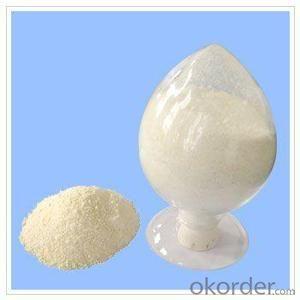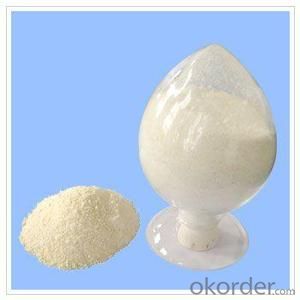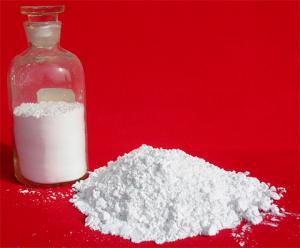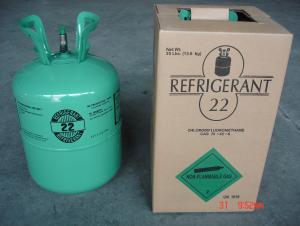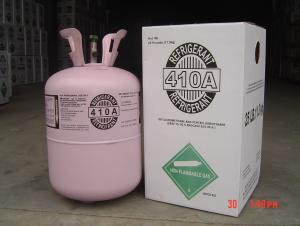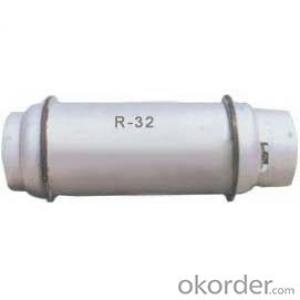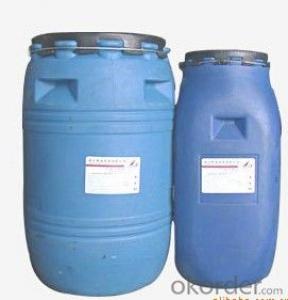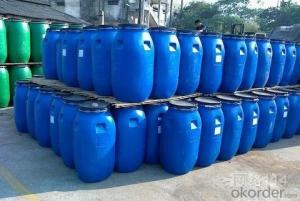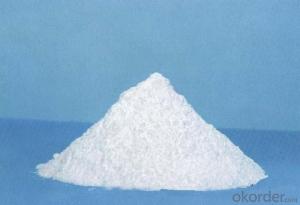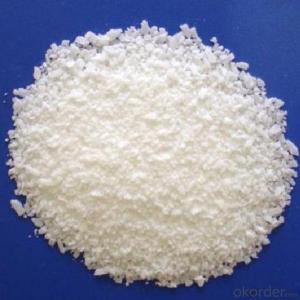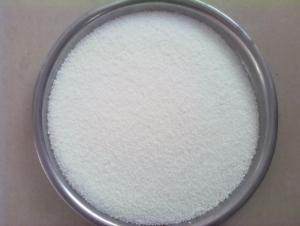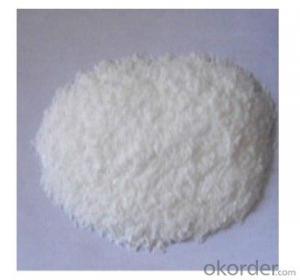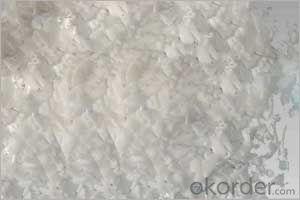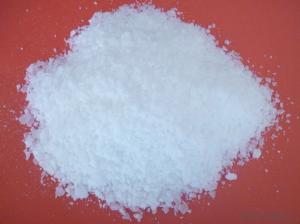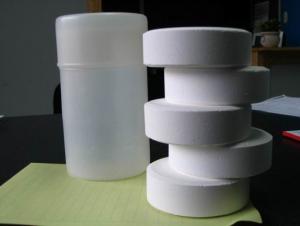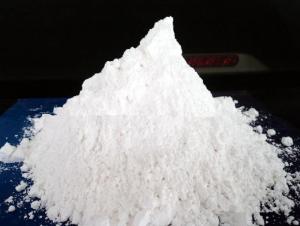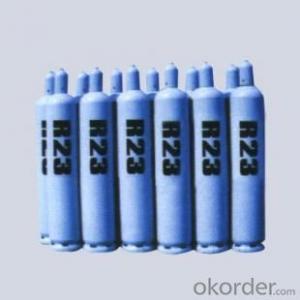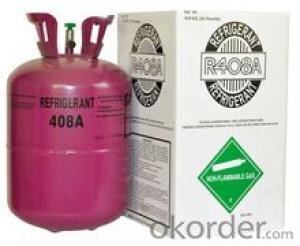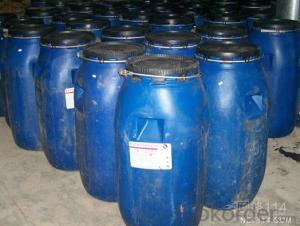Stearic Acid 200/400/800
- Loading Port:
- Tianjin
- Payment Terms:
- TT OR LC
- Min Order Qty:
- -
- Supply Capability:
- 8000MT/month m.t./month
OKorder Service Pledge
OKorder Financial Service
You Might Also Like
Stearic acid
Formula: C18H36O2
Structural Formula:CH3(CH2)16COOH
Product Description:
Shaped like Lump, flake; Saturated fatty acid mainly with C16 and C18, white flake solid at ambient temperature, not dissolved in water, slightly dissolved in benzene and carbon bisulfide, and easily dissolved in hot alcohol. No smell no poison. It has the general chemical properties of organic carboxylic acid.
Physicochemical Properties:
pure product is white with a shiny soft small pieces, melting point 69.6 degrees, the boiling point of 376.1 degrees. Relative density 0.9408, refractive index 1.4299, slowly volatile in the 90-100 degrees. Slightly soluble in cold water, soluble in alcohol, acetone, soluble in benzene, chloroform, ethyl ether, carbon tetrachloride, carbon disulfide, toluene and so on.
Specification:
Item | Index | |||||
Grade No. | 1842 | 1838 | 1820 | 1860 | 1870 | 1880 |
Iodine value gI2/100g ≤ | ≤5.0 | ≤5.0 | ≤5.0 | ≤6.0 | ≤7.0 | ≤8.0 |
Saponification value mgKOH/g | 206~211 | 206-213 | 214-216 | 193-220 | 193-220 | 192-218 |
Acid value mgKOH/g | 208~210 | 210~211.5 | 214-225 | 182-218 | 192-218 | 193-220 |
Chroma (Hazen) ≤ | ≤60 | ≤80 | ≤100 | 200-400 | ≤150 | 400 |
Freezing point °C | 54~57 | 54~57 | 55~57 | 54 | 52 | 52 |
Moisture % ≤ | ≤0.2 | ≤0.2 | ≤0.2 | ≤0.3 | ≤0.3 | ≤0.3 |
Inorganic acid % ≤ | 0.001 | 0.001 | 0.001 | 0.001 | 0.001 | 0.001 |
Suggest Uses:
Mainly for the production of stearic acid salts: Widely used system for cosmetics, plastic cold-resistant plasticizer, release agent, stabilizer, surfactants, rubber vulcanization accelerator, waterproof agent, polishing agent, metal soap, metal mineral flotation agent, softeners, pharmaceuticals, and other organic chemicals.
In addition, oil-soluble pigments can be used as solvents, crayons transfer slip agent, waxed paper lighting agent, stearic acid glyceride emulsifier, etc..
Packing :25/50kg in PP bag ,25MT/20GP
Product Storage:
in dry warehouse ventilation should be more than 10mm from the ground to avoid damp products in the above-mentioned conditions, from the date of delivery for one year shelf life.


- Q: What is the difference between an aromatic compound and a hydrocarbon derivative?
- The aromatic compound is a benzene ring containing compound, which may be a hydrocarbon or a hydrocarbon derivative. Hydrocarbons are hydrocarbon-containing compounds, and hydrocarbons containing hydrocarbons other than hydrocarbons are derivatives of hydrocarbons. The two concepts have crossed.
- Q: Is carbon monoxide an organic gas?
- The organic compound contains carbon, hydrogen, oxygen, nitrogen and other elements, a few also contain sulfur, phosphorus, halogen, etc. Any kind of organic compounds, its molecular composition contains carbon, the vast majority also contains hydrogen Elements. Since the hydrogen atoms of the organic compound molecules can be replaced by other atoms or radicals, resulting in a lot of other organic compounds, so modern people generally believe that hydrocarbons and their derivatives known as organic compounds, referred to as organic matter.
- Q: What is the derivative of benzene?
- Benzene homologues of the general formula: CnH2n-6 (n ≥ 6)
- Q: How to do it? Solve Inorganic Chemistry
- Inorganic chemistry is one of the earliest disciplines in the development of chemical science. It undertakes a major task of studying the composition, structure, properties and reactions of all elements and elements (except hydrocarbons and derivatives). The current development of inorganic chemistry has two distinct trends, that is, in the breadth of the broadening and depth of the advance. It is the three pillars of modern civilization
- Q: What are the characteristics of organic compounds?
- Organic compounds are usually referred to as carbon-containing compounds, or hydrocarbon-containing compounds and their derivatives are collectively referred to as organic matter. Organic compounds are generally insoluble in water and soluble in organic solvents with lower melting points. The vast majority of organic matter heat easily decomposed, easy to burn. The reaction of organic matter is generally slow and often accompanied by side effects, and there are many kinds of organic compounds, which can be divided into two major categories of hydrocarbon and hydrocarbon derivatives. According to the organic groups contained in the functional groups, divided into alkanes, alkenes, alkynes, aromatic hydrocarbons and alcohols, aldehydes, carboxylic acids, esters and so on. According to the organic carbon molecular structure, can also be divided into open chain compounds, carbocyclic compounds and heterocyclic compounds three categories.
- Q: Other corals are because the color of the corals show colorful, why only the red coral is the exception of it? did not find the reasons for the big god to explain
- Calcium coral is the main component of calcium carbonate, in addition to about 3% of magnesium carbonate and 1.5% to 4% of organic matter, and trace amounts of silicon and iron. The presence of organic matter increases the toughness of corals, making it better for processing and polishing. Calcium coral colors are mostly white or gray, but when it contains a considerable amount of different impurities, it is possible to show red, pink, orange, yellow, blue, purple and other colors. Therefore, by the living environment and many other factors, the same kind of coral can have different colors, and different types of corals and stars showing the same color. Red coral is really because of carotene.
- Q: Carboxylic acid and ester can form isomers. What are the conditions?
- The general formula for the carboxylic acid is RCOOH, and the general formula for the carboxylic acid ester is R? COOR? (R? May be a hydrogen atom). If the total number of carbon atoms in the R group in the carboxylic acid is the same as the total number of carbon atoms of the two R groups (R + R?) in the carboxylic acid ester and the total number of R atoms in the carboxylic acid is higher than that of the carboxyl groups R & lt; 1 & gt; R & lt; 2 & gt;), both of which constitute isomers, such as acetic acid and methyl formate, butyric acid and ethyl acetate, phenylacetic acid and methyl benzoate are all isomers.
- Q: Carboxylic acid in the end can not react with the new copper hydroxide
- But the formula is written in the carboxylic acid, because the reaction of aldehydes with the new copper hydroxide is alkaline conditions, the carboxylic acid is not present, but the carboxylic acid and alkali, copper hydroxide, copper oxide are reaction, Side reactions too much, too complex, in order to show that the reaction principle, simply from the simple processing, directly write carboxylic acid
- Q: Is the reaction of carboxylic acid and ammonia easy?
- Easy acid and alkali reaction
- Q: Commodity fine chemical industry is good or organic intermediates synthesis is better?
- Domestic in terms of the day I think the high-end enterprises are not good into Such as Procter & Gamble Unilever, demanding, treatment Ye Hao, two intermediates is probably a little bit toxic, but do protective measures should be okay
Send your message to us
Stearic Acid 200/400/800
- Loading Port:
- Tianjin
- Payment Terms:
- TT OR LC
- Min Order Qty:
- -
- Supply Capability:
- 8000MT/month m.t./month
OKorder Service Pledge
OKorder Financial Service
Similar products
Hot products
Hot Searches
Related keywords
